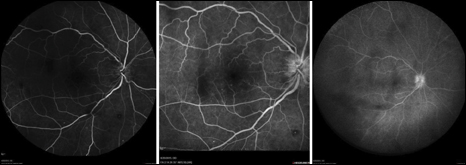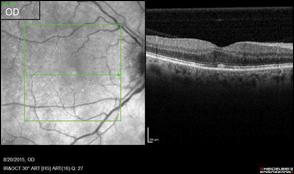Man presents with bilateral simultaneous acute onset uveitis
The patient denied any recent illness or antibiotic use.
A 65-year-old man with no significant medical or ocular history was referred by an outside optometrist to Tufts New England Eye Center for recurrent uveitis in both eyes. The patient had been treated by his optometrist with intermittent topical steroids for the past 5 months without relief.
Upon presentation at Tufts New England Eye Center, the patient complained of redness, photophobia and blurry vision in both eyes. These symptoms initially began 3 months prior with bilateral simultaneous acute onset. He had been off topical steroids for 3 weeks upon presentation. He denied any recent illness, recent use of antibiotics, gastrointestinal problems, back pain, trouble breathing or skin rash. He did note that he was recently told by his primary care physician that his routine blood work demonstrated a mildly abnormal kidney function, and he had been referred to nephrology.
Examination

Images: Bierman L, Rifkin L, Liang S

Upon examination at Tufts, the patient’s best corrected visual acuity was 20/30 in the right eye and 20/25 in the left eye. Pupils were equal, round and reactive with no relative afferent pupillary defect. IOP was 13 mm Hg in the right eye and 12 mm Hg in the left eye. The conjunctiva was white and quiet, and the corneal endothelium had diffuse fine keratic precipitates in both eyes. The anterior chamber showed 3+ cell in both eyes. There was posterior synechiae in the right eye and 2 to 3+ nuclear sclerotic cataracts in both eyes. On dilated fundus exam, the optic nerves had a cup-to-disc ratio of 0.3 bilaterally, as well as mild swelling and blurring of the nasal optic disc margin in the right eye. An inferior optic nerve hemorrhage was noted in the right eye. Fluorescein angiography and OCT of the macula are shown in Figures 1 and 2.
What is your diagnosis?
See answer on next page.
Bilateral simultaneous acute onset uveitis
Bilateral simultaneous acute onset uveitis is a rare entity, accounting for only 1% to 4% of all patients with uveitis. It has a limited number of etiologies, including sarcoidosis, syphilis, tuberculosis, post-infectious, drug-induced, HLA-B27, and tubulointerstitial nephritis and uveitis syndrome (TINU). In some cases it is idiopathic, but this is a diagnosis of exclusion.
Most often, the etiology is post-infectious or drug-induced, which may be on the TINU spectrum. Post-infectious bilateral uveitis usually occurs within 1 month of the onset of an illness, and serum antistreptolysin O titer can be elevated up to 2 months after the infection. Drug-induced bilateral uveitis due to medication use such as antibiotics or some anti-cancer treatments can occur during or up to several weeks after completing treatment course. HLA-B27-associated uveitis typically does not present as simultaneous in onset, but rather recurs in one eye at a time. TINU is a rare form of bilateral simultaneous onset anterior uveitis and acute interstitial nephritis that occurs more commonly in females than males and typically presents at a median age of 15 years.
In this patient, a workup was performed. This included serum ACE, lysozyme, FTA-Abs, RPR, QuantiFERON, chest X-ray, antistreptolysin O titer, HLA-B27 antigen and urine beta-2 microglobulin. Urine beta-2 microglobulin was found to be elevated, and the remainder of the testing was normal. The abnormal renal test result in conjunction with bilateral simultaneous acute onset iritis was consistent with a possible diagnosis of TINU. After discussion with the nephrologist, the decision was made to confirm this diagnosis with renal biopsy. Biopsy results indicated tubulointerstitial nephritis, thereby solidifying the diagnosis of TINU.
Discussion
Risk factors for TINU include antibiotic use, NSAIDs, autoimmune disease or recent infection. Approximately one-quarter of cases occur after antibiotic use and one-fifth of cases occur after use of an NSAID agent. Patients can present with acute interstitial nephritis before, after or at the same time as their ocular symptoms. In approximately 65% of reported TINU cases, the renal findings precede the ocular symptoms. Acute interstitial nephritis presents as nonspecific constitutional symptoms such as fever, weight loss and malaise, and therefore can often be overlooked by a patient. If renal function testing is performed, abnormalities can include elevated creatinine, non-nephritic range proteinuria, glycosuria, sterile pyuria and elevated urine beta-2 microglobulin. Of note, urine beta-2 microglobulin can be elevated months after the initial injury, which can be helpful if the patient does not seek medical attention initially but develops uveitis later on. Renal disease most often resolves spontaneously or with steroids; renal failure is rare. TINU has a high association with HLA-DRB1.
Uveitis in TINU patients most commonly presents as non-granulomatous anterior uveitis; however, intermediate or panuveitis is also a possible manifestation. Seventy-seven percent of patients present with bilateral symptoms, which may include pain, photophobia and hyperemia. Blurry vision and floaters are less common complaints. On exam, conjunctival injection, non-granulomatous keratic precipitates, impressive anterior chamber cell and flare, peripheral anterior synechiae and optic disc edema are typical findings. Pars plana exudate, cells in the anterior vitreous body, vasculitis and/or retinitis may also be seen. Unfortunately, uveitis in TINU may recur in about half of patients, thereby necessitating close, long-term follow-up. Complications include posterior synechiae, optic nerve swelling, cystoid macular edema, cataract formation and secondary glaucoma.
Treatment options include topical steroids with cycloplegic agents to prevent synechiae, periocular or intraocular steroids, and oral steroids. A steroid-sparing immunomodulatory agent can be used as a long-term treatment option.
Clinical course continued
The patient was immediately started on topical prednisolone every hour in both eyes and cyclopentolate every night at bedtime in both eyes while waiting for the results of the renal biopsy. Once TINU was confirmed, he was started on oral prednisone 60 mg daily to treat both the ocular and renal disease. Prednisone was tapered gradually over the next 3 months.
During that time, the patient stopped taking prednisone on his own due to weight gain. He subsequently developed a flare-up of bilateral simultaneous onset anterior uveitis. He was restarted on the prednisone, and his uveitis resolved. A decision was made to transition the patient to a steroid-sparing immunomodulatory agent due to recurrence and significant side effects of steroids, including weight gain and elevated blood sugar levels. He was started on mycophenolate mofetil 1 g twice daily. The prednisone was tapered and eventually discontinued. He developed inflammatory glaucoma and underwent tube shunt procedures in both eyes.
To date, the patient’s uveitis has been quiet for more than 6 months, and IOP has remained stable. He remains on mycophenolate mofetil 1 g twice daily and maintenance prednisolone drops once daily in both eyes. He continues to be followed by both the Uveitis and Glaucoma services.
- References:
- Barut K, et al. J Ophthalmic Inflamm Infect. 2015;doi:10.1186/s12348-015-0035-2.
- Brinbaum A, et al. Arch Ophthalmol. 2012;doi:10.1001/archophthalmol.2012.2006.
- Goda C, et al. Am J Ophthalmol. 2005;doi:10.1016/j.ajo.2005.04.019.
- Legendre M, et al. Medicine (Baltimore). 2016;doi:10.1097/MD.0000000000003964.
- Levinson RD. Int Ophthalmology Clin. 2008;doi:10.1097/IIO.0b013e31817d8455.
- Levinson RD, et al. Invest Ophthalmol Vis Sci. 2003;doi:10.1167/iovs.02-0376.
- Machensen F, et al. Br J Ophthalmol. 2011;doi:10.1136/bjo.2010.187955.
- Mandeville, et al. Surv Ophthalmol. 2001;doi:10.1016/S0039-6257(01)00261-2.
- Menezo V, et al. Eye. 2004;doi:10.1038/sj.eye.6700711.
- For more information:
- Lauren Bierman, MD, Lana Rifkin, MD, and Susan Liang, MD, can be reached at New England Eye Center, Tufts University School of Medicine, 750 Washington St., Box 450, Boston, MA 02111; website: www.neec.com.
- Edited by Jessica Moon, MD, and Emily C. Wright, MD. They can be reached at the New England Eye Center, Tufts University School of Medicine, 750 Washington St., Box 450, Boston, MA 02111; website: www.neec.com.









